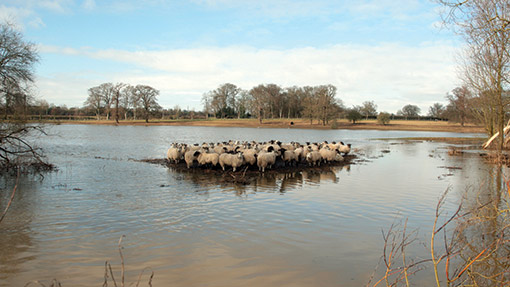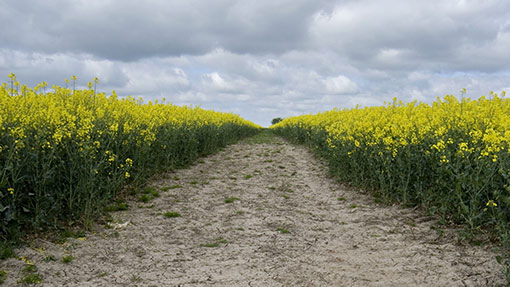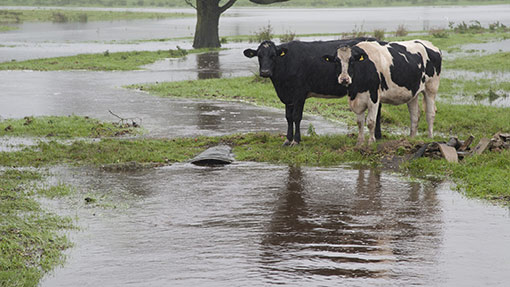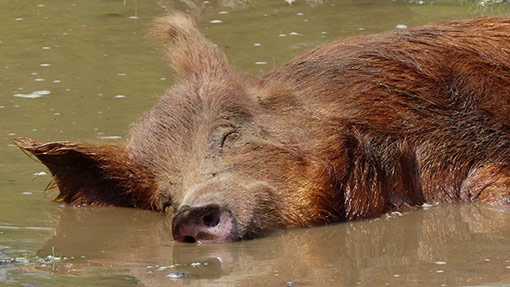Farmers Weekly 80th birthday: Prepare for climate change on your farm

Making your farm more weather-resilient makes good business sense. But with more volatile and extreme weather predicted, it becomes essential to short and long-term success.
So what are the threats your farm is likely to have to contend with? What doors may open with new opportunities?
See also: FW 80th birthday: Farming for climate change
And most importantly, what can you do to protect your farm business and exploit new avenues?
The following information was collated with the help of:
- Lorraine Hutt, senior advisor for agriculture and forestry for the Climate Ready Programme, Environment Agency
- Cerys Jones, climate change advisor, NFU
 Celebrating 80 years
Celebrating 80 years
of farming excellence
Farmers Weekly: 1934-2014 - Dr John Conway, director of research, Royal Agricultural University
- Prof John Turner, emeritus professor, University of East Anglia
Information was also taken from:
- UK Government Adaptation Sub-Committee
- Farming Futures

| Arable and horticulture | ||
|---|---|---|
| Threats | Opportunities | How a climate-ready farm might cope |
| • Erratic rainfall, with less in summer and more in winter. • Plant stress from more frequent and extended droughts and heatwaves. • Crop damage from intense storms and flooding. • Establishment problems due to wetter soils and waterlogging, and soil erosion due to flooding • Increasingly volatile global grain markets. • New pests, diseases and increased weeds, which stressed plants may be more susceptible to. • Water supply-demand imbalance due to increased needs from agriculture in summer and a growing UK population. • Cereal crop cultivation moves further north in England. • Land loss from coastal erosion. • Increased costs for improving cooling, wind- and floodproofing abilities of existing crop storage buildings. | • New crop varieties to overcome challenges such as drought. • Alternative (and niche) crops such as olives, peaches, sunflowers, apricots, soya beans, maize as grain crop, durum wheat, millet,sorghum, chickpea, grapes and other oilseed and starch crops. • Earlier harvests/longer growing seasons for some crops. • More favourable conditions in UK than in other countries. • Better growth further north than at present – Scotland may improve considerably. • Generally warmer temperatures encourage productivity (all other things being equal). • UK may be well placed to take advantage of higher prices and wider potential markets due to global crop shortages. • Home-grown markets could become more important in the face of volatile global supply and food insecurity. • Certain land management techniques – buffer strips, wetland creation, shelter belts – may create financial rewards. | • Make a risk assessment of your farm and business – have long- and short-term contingency plans. • Improve organic matter to make soils more resilient to erosion and drought. Use buffer strips, drainage ditches, ponds or wetlands toincrease infiltration rates. • Reduce risk of flooding – plough across slopes if possible and use cover crops to reduce soil exposure. • Collaborate with other farmers to build reservoirs and invest in irrigation to collect and store rainwater for times of shortage. • Investigate drought- and heat-resistant crop varieties. • Speak to supply chains about potential timing changes and agree an action plan. • Investigate local water availability. • Repair leaks, join or initiate an abstractor group to share knowledge and liaise with regulator. • Spray crops at night. • Plant shade/shelter belts for crops to protect against high temperatures. • Ensure buildings are maintained and prepared for more extreme weather. |

| Sheep, beef and dairy | ||
|---|---|---|
| Threats | Opportunities | How a climate-ready farm might cope |
| • Heat stress may change animals’ feed intake, reduce reproduction and milk yields. • Less stable spring/summer grass supply due to drought, heat stress, wet, or flooding leading to compromised winter forage. • More frequent and severe storms affecting upland pastures and cutting livestock off from food. • Insufficient access to drinking water during droughts. • Exotic diseases from increased global trade, higher temperatures and greater health risk from flooded pastures. • Inability of livestock buildings to cope – need for more cooling, heating, wind- and flood-proofing. • Increasingly volatile cost of feed. • Stock maintenance issues, such as housing during extreme weather. • Increased need to buy-in supplemental feed and silage. | • Warmer conditions improve grass in uplands and create greater opportunities at higher altitudes and further north. • Longer grazing seasons could increase productivity and reduce feed costs. • Agriculture expands to higher altitudes than currently possible. • Longer grazing seasons could increase productivity and reduce feed costs. • Bigger range of forage opportunities – chicory, lucerne, red clover and maize. • Possibilities of introducing new livestock species more suited to, for instance, warmer conditions. | • Make a farm risk assessment. Have long- and short-term contingency plans for different weather scenarios. • Align grass cutting or grazing regime with seasonal shifts. • Investigate grass and forage varieties that can cope with climate changes and establish diverse species pasture more resilient to grazingpressure and conditions. • Assess at-risk land and move livestock to higher ground when flooding is expected. • Improve drainage and incorporate buffer strips, drainage ditches, ponds or wetlands to increase soil infiltration. • Ensure buildings are prepared for more extreme weather, installing, for example, cooling in dairy parlours. • Collect and store rainwater. • Use hedgerows and trees for shelter/shade. • Tighten biosecurity. • Potentially alter lambing and calving in line with grass growth. • Consider replacing livestock breeds with ones better suited to conditions. • Closely observe emergence of new pests, diseases and weeds. • Propose alternative supply agreements with water company should mains water be unavailable. • Consider a contingency plan for milk storage and transport; seek advice from insurance company. • Ensure plenty of drinking water and sufficient airflow in buildings to prevent heat stress. |

| Pigs and poultry | ||
|---|---|---|
| Threats | Opportunities | How a climate-ready farm might cope |
| • Risk of heat stress in intensive indoor units, leading to lower productivity including feeding and fertility problems. • Increasingly volatile cost of feed. • Exotic diseases from increased global trade, higher temperatures and increased health risk from flooded buildings and land. • Inability of livestock buildings to cope with weather extremes – increased costs for cooling, heating, wind- and floodproofing. | • Use of excess heat in sheds to power renewable energy production. • Increased possibility of introducing new species or varieties. | • Make a risk assessment of your farm and business – plan for coping in different weather scenarios. • Manage housing and transportation to maintain optimal temperatures and cope with weather extremes. Consider investment in insulation,ventilation and climate-control systems. • Ensure plenty of drinking water, create shade areas and enable sufficient airflow indoors to prevent heat stress. • Assess at-risk land; outdoor pigs and poultry should be moved to higher ground when floods are expected. • Have a contingency plan for livestock sheds at risk of flooding. • Keep biosecurity tight. |
